Efficient Cryopreservation of Populus tremula by In Vitro-Grown Axillary Buds and Genetic Stability of Recovered Plants
Abstract
1. Introduction
2. Results
2.1. Analysis of the Pretreatment Effect on the Regenerant Survival Rate after Cryostorage
2.2. Analysis of the Aspen Transformed Genotypes Survival after Long-Term Cryopreservation
2.3. Assessment of Clonal Fidelity after Cryopreservation
3. Discussion
4. Materials and Methods
4.1. Plant Material
4.2. Preculture Treatments, Vitrification Procedure and Rapid Cooling
4.3. Thawing and Recovering
4.4. Analysis of Genotype Preservation after Cryostorage
4.5. Data Collection and Statistical Analysis
5. Conclusions
Author Contributions
Funding
Data Availability Statement
Conflicts of Interest
References
- Xiong, J.-S.; Ding, J.; Li, Y. Genome-editing technologies and their potential application in horticultural crop breeding. Hortic. Res. 2015, 2, 15019. [Google Scholar] [CrossRef]
- Chang, S.; Mahon, E.L.; MacKay, H.A.; Rottmann, W.H.; Strauss, S.H.; Pijut, P.M.; Powell, W.A.; Coffey, V.; Lu, H.; Mansfield, S.D.; et al. Genetic engineering of trees: Progress and new horizons. Vitr. Cell. Dev. Biol. Plant 2018, 54, 341–376. [Google Scholar] [CrossRef]
- Allona, I.; Kirst, M.; Boerjan, W.; Strauss, S.; Sederoff, R. Editorial: Forest genomics and biotechnology. Front. Plant Sci. 2019, 10, 1187. [Google Scholar] [CrossRef] [PubMed]
- Jokipii, S.; Ryynänen, L.; Kallio, P.T.; Aronen, T.; Häggman, H. A cryopreservation method maintaining the genetic fidelity of a mode forest tree, Populus tremula L. × Populus tremuloides Michx. Plant Sci. 2004, 166, 799–806. [Google Scholar] [CrossRef]
- Lambardi, M.; Shaarawi, S. Importance of in vitro culture for developing cryopreservation strategies of woody plants. Acta Hortic. 2017, 1187, 177–188. [Google Scholar] [CrossRef]
- Boxus, P.; Read, P.E.; O’Riordain, F. Symposium on In Vitro Problems Related to Mass Propagation of Horticultural Plants; ISHS Acta Horticulturae: Gembloux, Belgium, 1987; p. 350. [Google Scholar]
- Bajaj, Y.P.S. Storage and Cryopreservation of in Vitro Cultures. In Biotechnology in Agriculture and Forestry, 17th, ed.; Bajaj, Y.P.S., Ed.; Springer International Publishing AG: Cham, Switzerland, 1991; pp. 361–381. [Google Scholar]
- Sarasan, V.; Cripps, R.; Ramsay, M.M.; Atherton, C.; McMichen, M.; Prendergast, G.; Rowntree, J.K. Conservation in vitro of threatened plants–progress in the past decade. Vitr. Cell. Dev. Biol. Plant 2006, 42, 206–214. [Google Scholar] [CrossRef]
- Bunn, E.; Turner, S.; Panaia, M.; Dixon, K.W. The contribution of in vitro technology and cryogenic storage to conservation of indigenous plants. Aust. J. Bot. 2007, 55, 345–355. [Google Scholar] [CrossRef]
- Maki, S.; Hirai, Y.; Niino, T.; Matsumoto, T. Assessment of molecular genetic stability between long-term cryopreserved and tissue cultured wasabi (Wasabia japonica) plants. CryoLetters 2015, 36, 318–324. [Google Scholar]
- Ugya, A.Y.; Aliyu, M.A. Conservation of Plant Biodiversity: With Reference to the Role of Biotechnology. In Wastewater Remediation Using Plant Techniques; Ugya, A.Y., Aliyu, M.A., Eds.; Lulu Publishers: Morrisville, NC, USA, 2016; pp. 110–156. [Google Scholar]
- Streczynski, R.; Clark, H.; Whelehan, L.M.; Ang, S.-T.; Hardstaff, L.K.; Funnekotter, B.; Bunn, E.; Offord, C.A.; Sommerville, K.D.; Mancera, R.L. Current issues in plant cryopreservation and importance for ex situ conservation of threatened Australian native species. Aust. J. Bot. 2019, 67, 1–15. [Google Scholar] [CrossRef]
- Ryynänen, L. Survival and regeneration of dormant silver birch buds stored at super-low temperatures. Can. J. For. Res. 1996, 26, 617–623. [Google Scholar] [CrossRef]
- Lambardi, M.; Fabbri, A.; Caccavale, A. Cryopreservation of white poplar (Populus alba L.) by vitrification of in vitro-grown shoot tips. Plant Cell Rep. 2000, 19, 213–218. [Google Scholar] [CrossRef] [PubMed]
- Tsvetkov, I.; Benelli, C.; Capuana, M.; De Carlo, A.; Lambardi, M. Application of vitrification-derived cryotechniques for long-term storage of poplar and aspen (Populus spp.) germplasm. Agric. Food Sci. 2009, 18, 160–166. [Google Scholar] [CrossRef][Green Version]
- Espinosa-Leal, C.A.; Puente-Garza, C.A.; García-Lara, S. In vitro plant tissue culture: Means for production of biological active compounds. Planta 2018, 248, 1–18. [Google Scholar] [CrossRef] [PubMed]
- Wang, B.; Zhang, Z.; Yin, Z.; Feng, C.; Wang, Q. Novel and potential application of cryopreservation to plant genetic transformation. Biotechnol. Adv. 2012, 30, 604–612. [Google Scholar] [CrossRef]
- Sakai, A.; Hirai, D.; Niino, T. Development of PVS-Based Vitrification and Encapsulation–Vitrification Protocols. In Plant Cryopreservation: A Practical Guide; Reed, B.M., Ed.; Springer: New York, NY, USA, 2008; pp. 33–57. [Google Scholar] [CrossRef]
- Engelmann, F. Cryopreservation of clonal crops: A review of key parameters. Acta Hortic. 2014, 1039, 31–39. [Google Scholar] [CrossRef]
- Sakai, A.; Kobayashi, S.; Oiyama, I. Cryopreservation of nucellar cells of navel orange (Citrus sinensis Osb. var. brasiliensis Tanaka) by vitrification. Plant Cell Rep. 1990, 9, 30–33. [Google Scholar] [CrossRef]
- Benson, E.E. Cryopreservation Theory. Chapter 2. In Plant Cryopreservation: A Practical Guide; Reed, B.M., Ed.; Springer: New York, NY, USA, 2008; pp. 15–32. [Google Scholar] [CrossRef]
- Feng, C.H.; Li, B.Q.; Hu, L.Y.; Wang, M.R.; Wang, Q.C. A comparison of two cryogenic protocols in cryopreservation of apple shoot tips. Acta Hortic. 2014, 1039, 161–166. [Google Scholar] [CrossRef]
- Pokorná, E.; Faltus, M.; Máchová, P.; Zámečník, J.; Fulín, M. Grey poplar explant acclimation to improve the dehydration tolerance and cryopreservation. Biol. Plant. 2020, 64, 119–128. [Google Scholar] [CrossRef]
- Tsai, C.-J.; Hubscher, S.L. Cryopreservation in Populus functional genomics. New Phytol. 2004, 164, 73–81. [Google Scholar] [CrossRef]
- Bryant, N.D.; Pu, Y.; Tschaplinski, T.J.; Tuskan, G.A.; Muchero, W.; Kalluri, U.C.; Yoo, C.G.; Ragauskas, A.J. Transgenic Poplar Designed for Biofuels. Trends Plant Sci. 2020, 25, 881–896. [Google Scholar] [CrossRef]
- Crossa, J.; Pérez-Rodríguez, P.; Cuevas, J.; Montesinos-López, O.; Jarquín, D.; de los Campos, G.; Burgueño, J.; Camacho-González, J.M.; Pérez-Elizalde, S.; Beyene, Y.; et al. Genomic Selection in Plant Breeding: Methods, Models, and Perspectives. Trends Plant Sci. 2017, 22, 961–975. [Google Scholar] [CrossRef] [PubMed]
- Bradshaw, H.D.; Ceulemans, R.; Davis, J.; Stettler, R.F. Emerging model systems in plant biology: Poplar (Populus) as a model forest tree. J. Plant Growth Regul. 2000, 19, 306–313. [Google Scholar] [CrossRef]
- Kiem, P.; Paige, K.N.; Whitham, T.G.; Lark, K.G. Genetic analysis of an interspecific hybrid swarm of Populus: Occurrence of unidirectional introgression. Genetics 1989, 123, 557–565. [Google Scholar]
- Barra-Jiménez, A.; Aronen, T.S.; Alegre, J.; Toribio, M. Cryopreservation of embryogenic tissues from mature holm oak trees. Cryobiology 2015, 70, 217–225. [Google Scholar] [CrossRef]
- Krajňáková, J.; Sutela, S.; Aronen, T.; Gömöry, D.; Vianello, A.; Häggman, H. Long-term cryopreservation of Greek fir embryogenic cell lines: Recovery, maturation and genetic fidelity. Cryobiology 2011, 63, 17–25. [Google Scholar] [CrossRef]
- Aronen, T.; Ryynanen, L. Cryopreservation of dormant in vivo- buds of hybrid aspen: Timing as critical factor. Cryoletters 2014, 35, 385–394. [Google Scholar]
- Vidyagina, E.O.; Subbotina, N.M.; Belyi, V.A.; Lebedev, V.G.; Krutovsky, K.V.; Shestibratov, K.A. Various effects of the expression of the xyloglucanase gene from Penicillium canescens in transgenic aspen under semi-natural conditions. BMC Plant Biol. 2020, 20, 1–14. [Google Scholar] [CrossRef]
- Rahman, M.H.; Rajora, O.P. Microsatellite DNA somaclonal variation in micropropagated trembling aspen (Populus tremuloides). Plant Cell Rep. 2001, 20, 531–536. [Google Scholar] [CrossRef]
- Bettoni, J.C.; Kretzschmar, A.A.; Bonnart, R.; Shepherd, A.; Volk, G.M. Cryopreservation of 12 Vitis species using apical shoot tips derived from plants grown in vitro. HortScience 2019, 54, 976–981. [Google Scholar] [CrossRef]
- Vidyagina, E.O.; Kovalitskaya, Y.A.; Loginov, D.S.; Koroleva, O.V.; Shestibratov, K.A. Expression of xyloglucanase sp-Xeg gene from Penicillium canescens accelerates growth and rooting in transgenic aspen plants. Appl. Biochem. Microbiol. 2014, 50, 701–708. [Google Scholar] [CrossRef]
- Zhu, G.Y.; Geuns, J.M.C.; Dussert, S.; Swennen, R.; Panis, B. Change in sugar, sterol and fatty acid composition in banana meristems caused by sucrose-induced acclimation and its effects on cryopreservation. Physiol. Plant. 2006, 128, 80–94. [Google Scholar] [CrossRef]
- Scottez, C. Cryoconservation après encapsulation-déshydratationd’apex de Poirier (Pyrus communis L. cv. Beurré Hardy) cultivés in vitro: Effets d’un endurcissement par les basses temperatures et etude du métabolisme des lipids. Ph.D. Thesis, Univ. Université Pierre et Marie Curie, Paris, France, 1993. [Google Scholar]
- Chang, Y.; Reed, B.M. Extended cold acclimation and recovery medium alteration improve regrowth of Rubus shoot tips following cryopreservation. CryoLetters 1999, 20, 371–376. [Google Scholar]
- Chang, Y.; Reed, B.M. Extended alternating-temperature cold acclimation and culture duration improve pear shoot cryopreservation. Cryobiology 2000, 40, 311–322. [Google Scholar] [CrossRef] [PubMed]
- Charoensub, R.; Phansiri, S.; Yongmenitchai, W.; Sakai, A. Routine cryopreservation of in vitro grown axillary apices of cassava (Manihot esculenta Crantz) by vitrification: Importance of a simple monodal culture. Sci. Hortic. 2003, 98, 485–492. [Google Scholar] [CrossRef]
- Thinh, N.T.; Takagi, H.; Sakai, A. Cryopreservation of in vitro grown apical meristems of some vegetatively propagated tropical monocots by vitrification. In Cryopreservation of Tropical Plant Germplasm; Engelmann, F., Takagi, H., Eds.; Current Research and Applications, IPGRI/Rome and JIRCAS: Tsukuba, Japan, 2000; pp. 227–232. [Google Scholar]
- Thinh, N.T.; Takagi, H. Cryopreservation of in vitro grown apical meristems of terrestrial orchids (Cymbidium spp.) by vitrification. In Cryopreservation of Tropical Plant Germplasm; Engelmann, F., Takagi, H., Eds.; Current Research and Applications, IPGRI/Rome and JIRCAS: Tsukuba, Japan, 2000; pp. 441–443. [Google Scholar]
- Jones, A.R.; Forero-Vargas, M.; Withers, S.P.; Smith, R.S.; Traas, J.; Dewitte, W.; Murray, J.A.H. Cell-size dependent progression of the cell cycle creates homeostasis and flexibility of plant cell size. Nat. Commun. 2017, 8, 15060. [Google Scholar] [CrossRef]
- Hirsh, A.G. Vitrification in plants as a natural form of cryoprotection. Cryobiology 1987, 24, 214–228. [Google Scholar] [CrossRef]
- Fahy, G.N.; MacFarlane, D.R.; Angell, C.A.; Meryman, H.T. Vitrification as an approach to cryopreservation. Cryobiology 1984, 21, 407–426. [Google Scholar] [CrossRef]
- Taylor, M.J.; Song, Y.C.; Brockbank, K.G.M. Vitrification in tissue preservation: New developments. In Life in the Frozen State; Fuller, B., Lane, N., Benson, E.E., Eds.; CRC Press: London, UK, 2004; pp. 603–644. [Google Scholar]
- Volk, G.M.; Henk, A.D.; Jenderek, M.M.; Richards, C.M. Probabilistic viability calculations for cryopreserving vegetatively propagated collections in genebanks. Genet. Resour. Crop. Evol. 2016, 64, 1613–1622. [Google Scholar] [CrossRef]
- Dayanandan, S.; Rajora, O.P.; Bawa, K.S. Isolation and characterization of microsatellites in trembling aspen (Populus tremuloides). Theor. Appl. Genet. 1998, 96, 950–956. [Google Scholar] [CrossRef]
- Rahman, M.H.; Dayanandan, S.; Rajora, O.P. Microsatellite DNA markers in Populus tremuloides. Genome 2000, 43, 293–297. [Google Scholar] [CrossRef]
- Lebedev, V.G.; Faskhiev, V.N.; Kovalenko, N.P.; Shestibratov, K.A.; Miroshnikov, A.I. Testing Transgenic Aspen Plants with bar Gene for Herbicide Resistance under Semi-natural Conditions. Acta Nat. 2016, 8, 92–101. [Google Scholar] [CrossRef]
- Lloyd, G.; McCown, B. Commercially feasiblemicropropagation of mountain laural (Kalmla latlfolia) by use of shoot tip cultures. Ccmb. Proc. Intl. Soc. 1980, 30, 421–427. [Google Scholar]
- Murashige, T.; Skoog, F.M. A revised medium for rapid growth and bioassays with tobacco tissue culture. Physiol. Plant. 1962, 15, 473–497. [Google Scholar] [CrossRef]
- Sakai, A.; Kobayashi, S.; Oiyama, I. Survival by vitrification of nucellar cells of navel orange (Citrus sinensis var. brasiliensis) cooled to −196 °C. J. Plant Physiol. 1991, 137, 465–470. [Google Scholar] [CrossRef]
- Marascuilo, L.A.; McSweeney, M. Nonparametric and Distribution-Free Methods for the Social Science; Brooks/Cole: Belmont, CA, USA, 1977; pp. 141–147. [Google Scholar]
- Hesami, M.; Naderi, R.; Tohidfar, M. Introducing a hybrid artificial intelligence method for high-throughput modeling and optimizing plant tissue culture processes: The establishment of a new embryogenesis medium for chrysanthemum, as a case study. Appl. Microbiol. Biotechnol. 2020, 104, 10249–10263. [Google Scholar] [CrossRef]
- Zhang, Q.; Deng, D.; Dai, W.; Li, J.; Jin, X. Optimization of culture conditions for differentiation of melon based on artificial neural network and genetic algorithm. Sci. Rep. 2020, 10, 3524. [Google Scholar] [CrossRef]
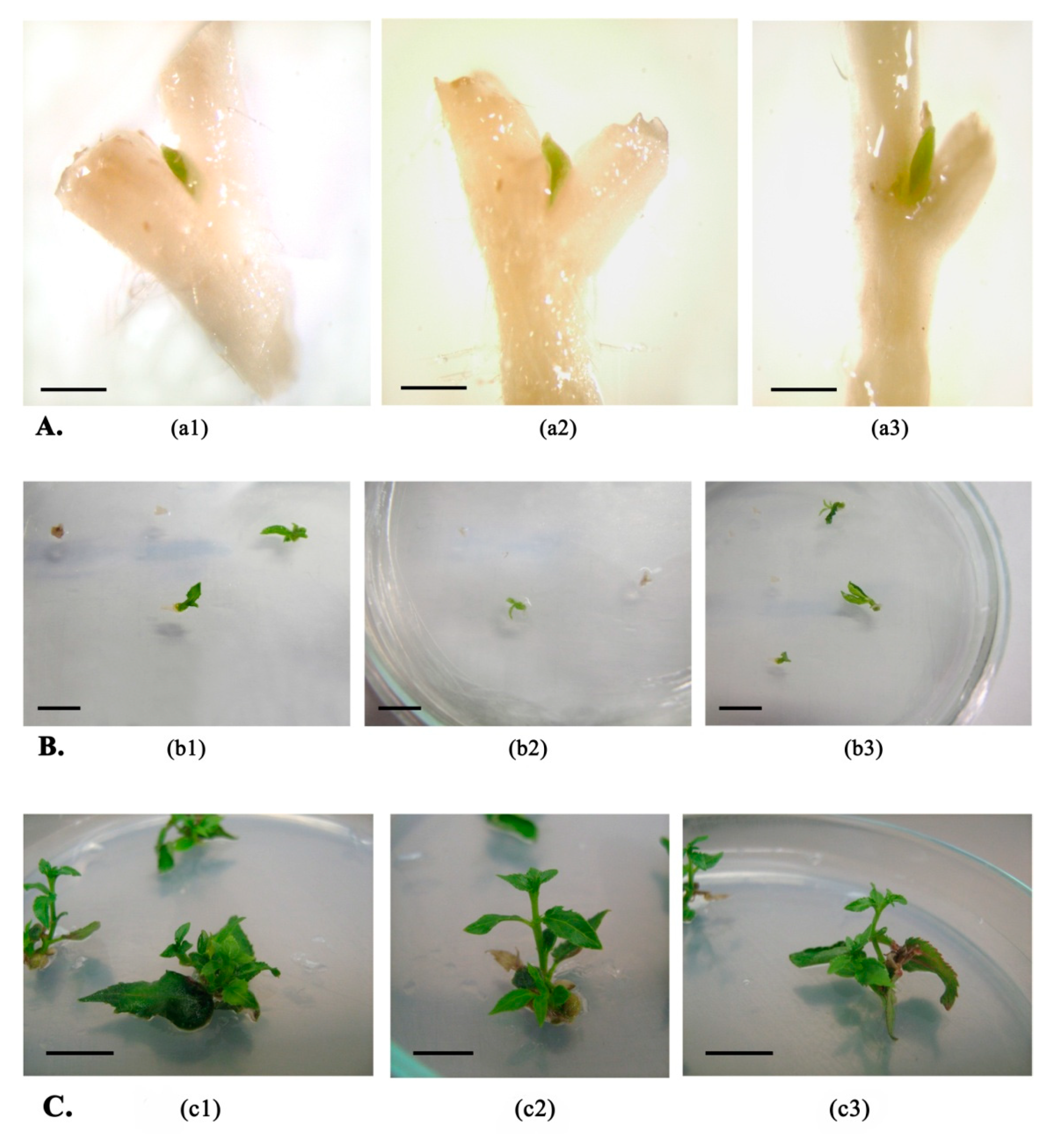

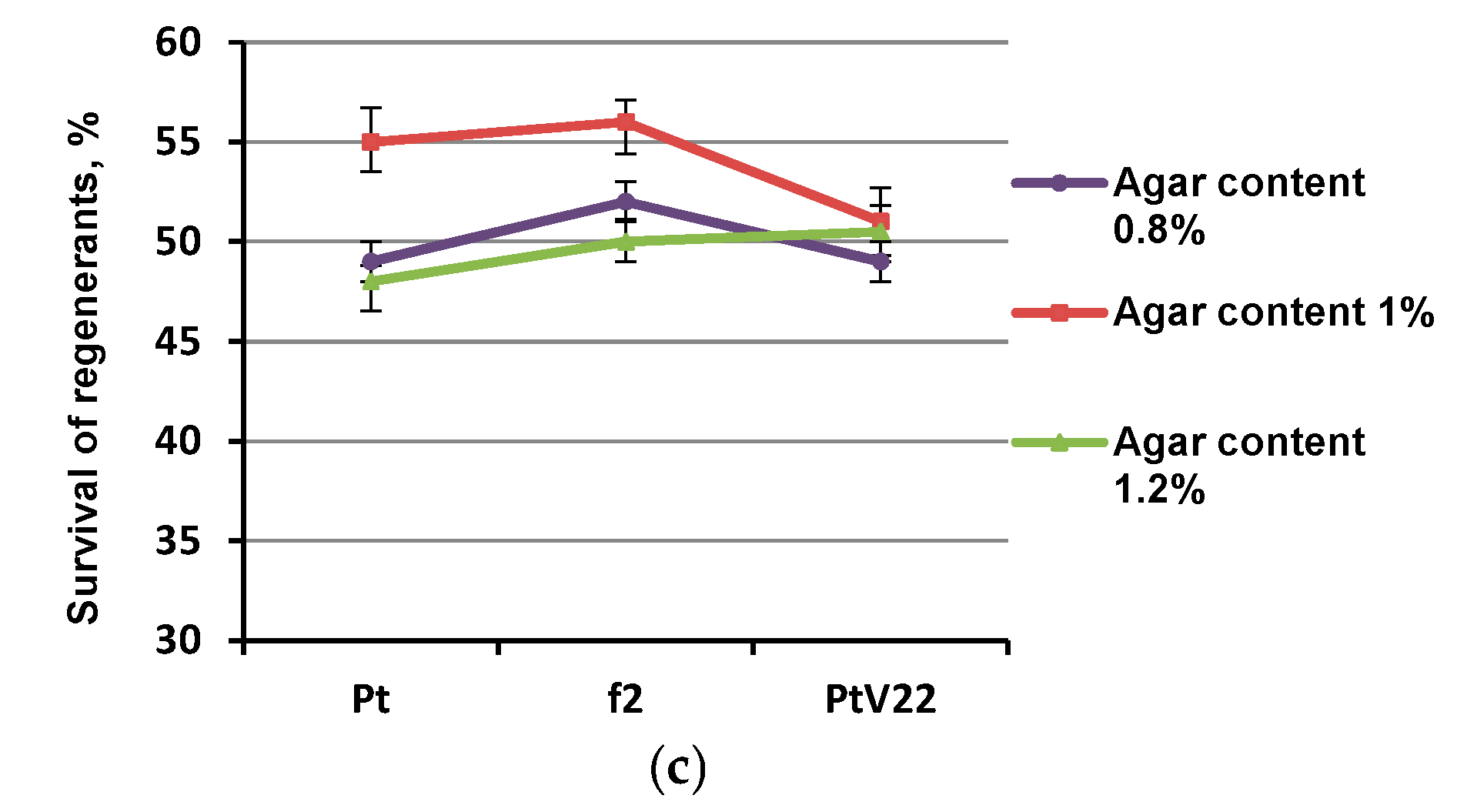
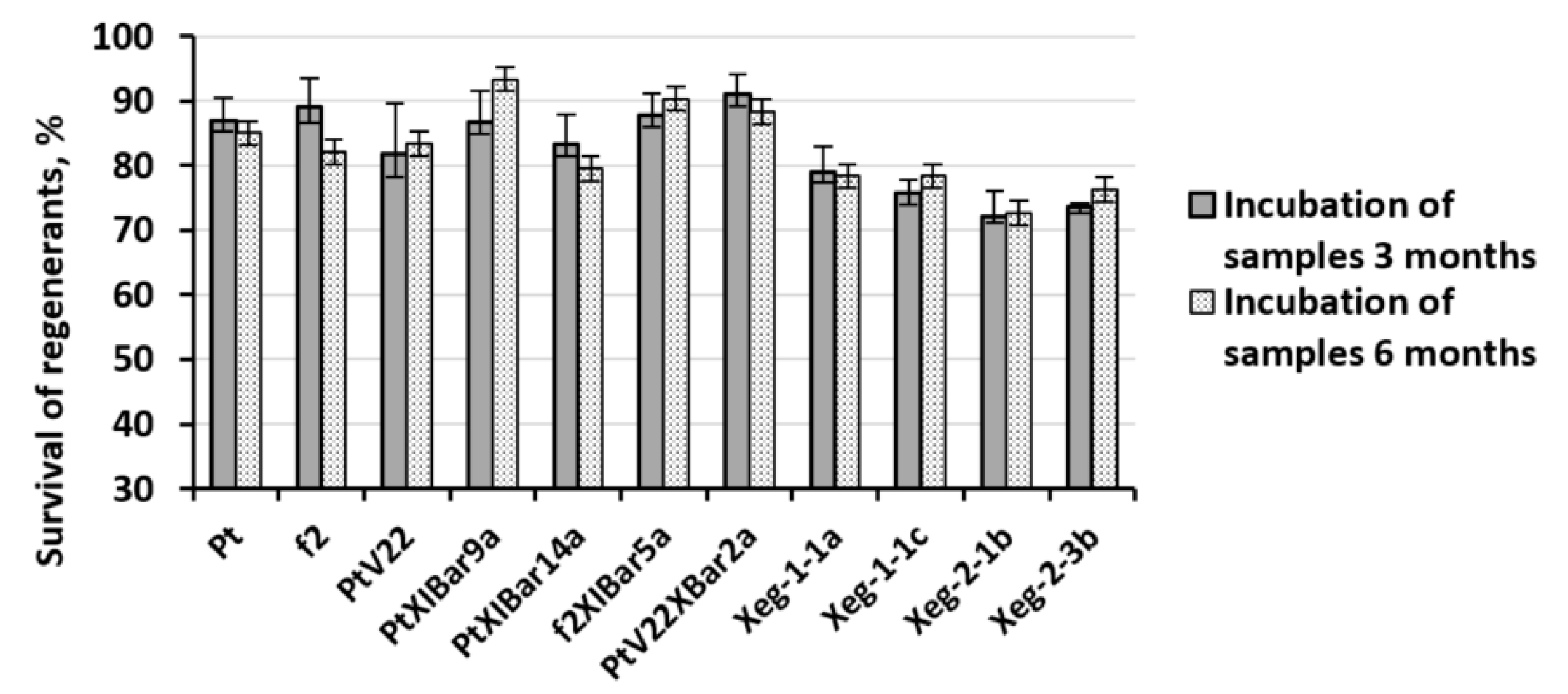
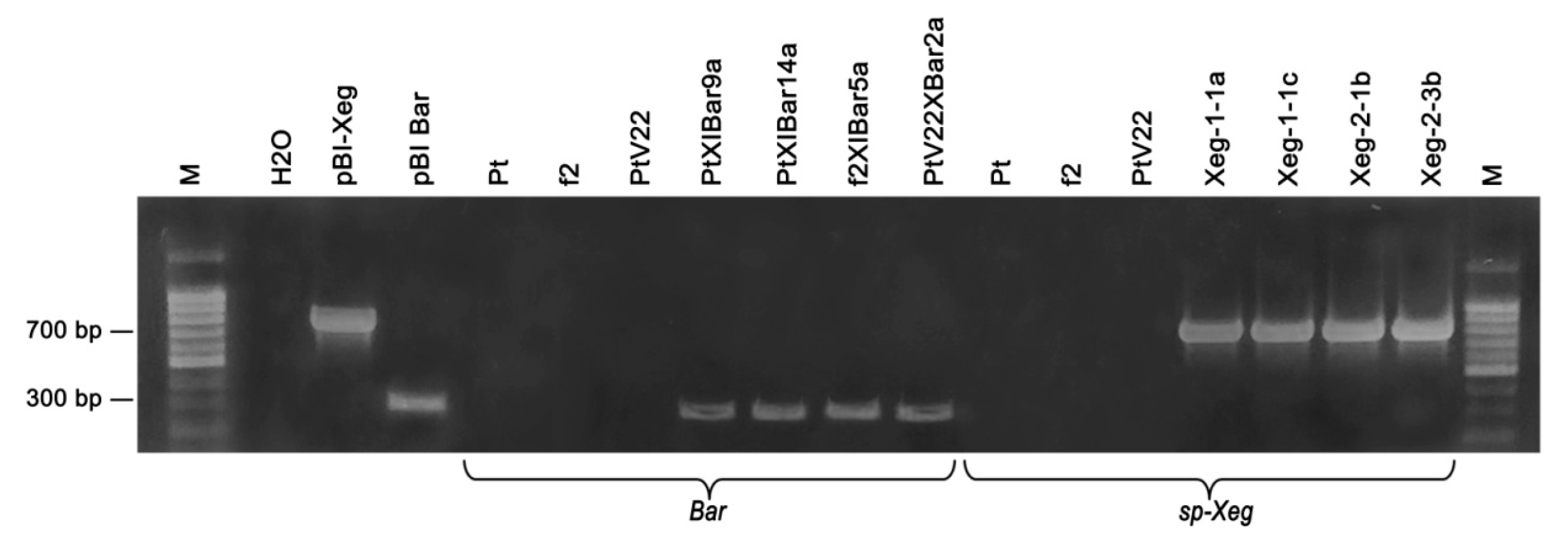
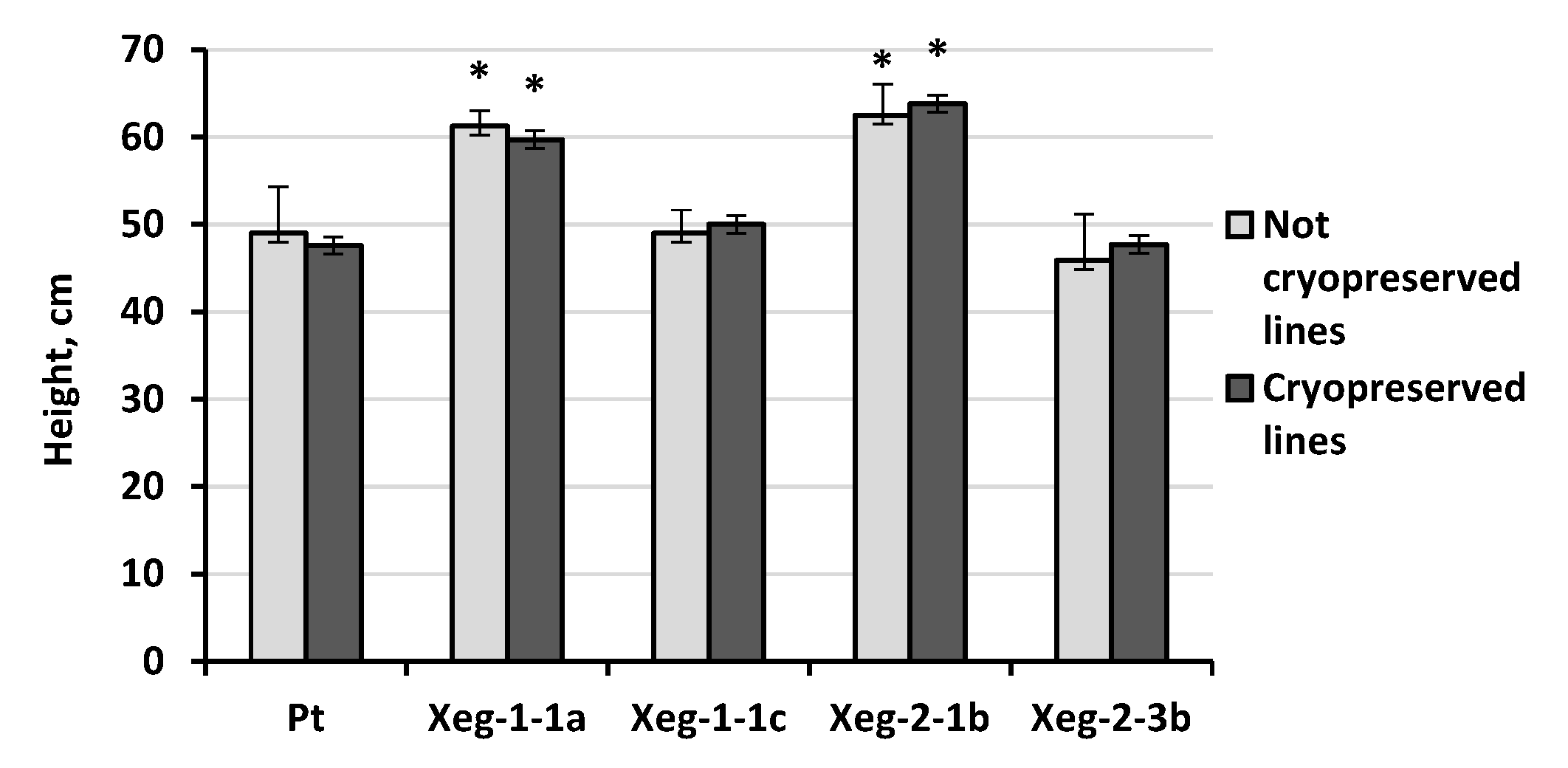
| Lines | Sample Status | PTR2 | PTR3 | PTR4 | PTR5 | PTR6 | PTR14 |
|---|---|---|---|---|---|---|---|
| Pt | C | 204/204 | 197/201 | 215/212 | 258/258 | 247/243 | 163/159 |
| F | 204/204 | 197/201 | 215/212 | 258/258 | 247/243 | 163/159 | |
| f2 | C | 204/204 | 195/195 | 217/196 | 258/258 | 247/243 | 181/162 |
| F | 204/204 | 195/195 | 217/196 | 258/258 | 247/243 | 181/162 | |
| PtV22 | C | 204/204 | 197/195 | 215/197 | 257/257 | 243/243 | 176/156 |
| F | 204/204 | 197/195 | 215/197 | 257/257 | 243/243 | 176/156 | |
| PtXIBar9a | C | 204/204 | 197/201 | 215/212 | 258/258 | 248/243 | 165/156 |
| F | 204/204 | 197/201 | 215/212 | 258/258 | 248/243 | 165/156 | |
| PtXIBar14a | C | 204/204 | 195/195 | 215/212 | 258/258 | 247/243 | 163/159 |
| F | 204/204 | 195/195 | 215/212 | 258/258 | 247/243 | 163/159 | |
| f2XIBar5a | C | 204/204 | 195/195 | 196/196 | 258/258 | 247/243 | 181/162 |
| F | 204/204 | 195/195 | 196/196 | 258/258 | 247/243 | 181/162 | |
| PtV22XBar2a | C | 204/204 | 197/195 | 215/197 | 257/257 | 243/243 | 176/156 |
| F | 204/204 | 197/195 | 215/197 | 257/257 | 243/243 | 176/156 | |
| Xeg-1-1a | C | 204/204 | 197/201 | 215/212 | 258/258 | 247/243 | 177/161 |
| F | 204/204 | 197/201 | 215/212 | 258/258 | 247/243 | 177/161 | |
| Xeg-1-1c | C | 204/204 | 197/197 | 215/212 | 258/258 | 243/226 | 163/159 |
| F | 204/204 | 197/197 | 215/212 | 258/258 | 243/226 | 163/159 | |
| Xeg-2-1b | C | 204/197 | 199/197 | 215/212 | 257/258 | 247/243 | 163/156 |
| F | 204/197 | 199/197 | 215/212 | 257/258 | 247/243 | 163/156 | |
| Xeg-2-3b | C | 204/204 | 197/197 | 215/212 | 258/258 | 248/243 | 163/159 |
| F | 204/204 | 197/197 | 215/212 | 258/258 | 248/243 | 163/159 |
Publisher’s Note: MDPI stays neutral with regard to jurisdictional claims in published maps and institutional affiliations. |
© 2021 by the authors. Licensee MDPI, Basel, Switzerland. This article is an open access article distributed under the terms and conditions of the Creative Commons Attribution (CC BY) license (http://creativecommons.org/licenses/by/4.0/).
Share and Cite
Vidyagina, E.O.; Kharchenko, N.N.; Shestibratov, K.A. Efficient Cryopreservation of Populus tremula by In Vitro-Grown Axillary Buds and Genetic Stability of Recovered Plants. Plants 2021, 10, 77. https://doi.org/10.3390/plants10010077
Vidyagina EO, Kharchenko NN, Shestibratov KA. Efficient Cryopreservation of Populus tremula by In Vitro-Grown Axillary Buds and Genetic Stability of Recovered Plants. Plants. 2021; 10(1):77. https://doi.org/10.3390/plants10010077
Chicago/Turabian StyleVidyagina, Elena O., Nikolay N. Kharchenko, and Konstantin A. Shestibratov. 2021. "Efficient Cryopreservation of Populus tremula by In Vitro-Grown Axillary Buds and Genetic Stability of Recovered Plants" Plants 10, no. 1: 77. https://doi.org/10.3390/plants10010077
APA StyleVidyagina, E. O., Kharchenko, N. N., & Shestibratov, K. A. (2021). Efficient Cryopreservation of Populus tremula by In Vitro-Grown Axillary Buds and Genetic Stability of Recovered Plants. Plants, 10(1), 77. https://doi.org/10.3390/plants10010077




